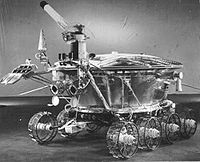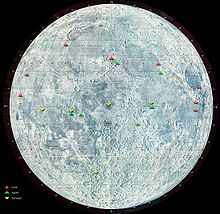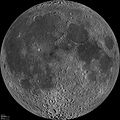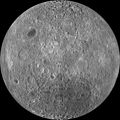- Exploration of the Moon
-
The physical exploration of the Moon began when Luna 2, a space probe launched by the Soviet Union, made an impact on the surface of the Moon on September 14, 1959. Prior to that the only available means of exploration had been observation. The invention of the optical telescope brought about the first leap in the quality of lunar observations. Galileo Galilei is generally credited as the first person to use a telescope for astronomical purposes; having made his own telescope in 1609, the mountains and craters on the lunar surface were among his first observations using it.
In 1969, NASA's Project Apollo first successfully landed people on the Moon. They placed scientific experiments there and returned rocks and data that suggested the Moon is of a similar composition to the Earth.
Contents
Early history
See also: Selenography and Lunar theoryIn Mesopotamia, Babylonian astronomers by the early first millennium BC had discovered a repeating 18-year cycle of lunar eclipses. They had also known by this time that 19 solar years is about equal to 235 lunar months.[1][not in citation given] In the 2nd century BC, Seleucus of Seleucia correctly theorized that tides were caused by the Moon, although he believed that the interaction was mediated by the Earth's atmosphere. According to Strabo (1.1.9), Seleucus was the first to state that the tides are due to the attraction of the Moon, and that the height of the tides depends on the Moon's position relative to the Sun.[2]
By the mid-first millennium BC, Indian astronomers described the Moon’s monthly elongation in the Aitareya Brāhmana.[3] By 499 AD, the Indian astronomer Aryabhata mentioned in his Aryabhatiya that reflected sunlight is the cause behind the shining of the moon.[4]
Among the first in the Western world to offer a scientific explanation for the Moon was the Greek philosopher Anaxagoras (d. 428 BC), who reasoned that the Sun and Moon were both giant spherical rocks, and that the latter reflected the light of the former. His atheistic view of the heavens was one cause for his imprisonment and eventual exile.[5] In Aristotle's (384–322 BC) description of the universe, the Moon marked the boundary between the spheres of the mutable elements (earth, water, air and fire), and the imperishable stars of aether. This separation was held to be part of Aristotelian physics for many centuries after.[6] In the philosophy of Aristotle, the heavens, starting at the Moon, were the realm of perfection, the sublunary region was the realm of change and corruption, and any resemblance between these regions was strictly ruled out. Aristotle himself suggested that the Moon partook perhaps of some contamination from the realm of corruption.[7] In his little book On the Face in the Moon's Orb, Plutarch expressed rather different views on the relationship between the Moon and Earth. He suggested that the Moon had deep recesses in which the light of the Sun did not reach and that the spots are nothing but the shadows of rivers or deep chasms. He also entertained the possibility that the Moon was inhabited. It had been suggested already in antiquity that the Moon was a perfect mirror and that its markings were reflections of earthly features, but this explanation was easily dismissed because the face of the Moon never changes as it moves about the Earth.[7] The explanation that finally became standard was that there were variations of "density" in the Moon that caused this otherwise perfectly spherical body to appear the way it does.[7] The perfection of the Moon, and therefore the heavens, was thus preserved. Aristarchus went a step further and computed the distance from Earth, together with its size, obtaining a value of 20 times the Earth radius for the distance (the real value is 60; the Earth radius was roughly known since Eratosthenes).
During the Warring States of China, astronomer Shi Shen (fl. 4th century BC) gave instructions for predicting solar and lunar eclipses based on the relative positions of the Moon and Sun.[8] Although the Chinese of the Han Dynasty (202 BC–202 AD) believed the Moon to be energy equated to qi, their 'radiating influence' theory recognized that the light of the Moon was merely a reflection of the Sun (mentioned by Anaxagoras above).[9] This was supported by mainstream thinkers such as Jing Fang (78–37 BC) and Zhang Heng (78–139 AD), but it was also opposed by the influential philosopher Wang Chong (27–97 AD).[9] Jing Fang noted the sphericity of the Moon, while Zhang Heng accurately described a lunar eclipse and solar eclipse.[9][10] These assertions were supported by Shen Kuo (1031–1095) of the Song Dynasty (960–1279) who created an allegory equating the waxing and waning of the Moon to a round ball of reflective silver that, when doused with white powder and viewed from the side, would appear to be a crescent.[11] He also noted that the reason for the Sun and Moon not eclipsing every time their paths met was because of a small obliquity in their orbital paths.[11]
Habash al-Hasib al-Marwazi, a Persian astronomer, conducted various observations at the Al-Shammisiyyah observatory in Baghdad between 825 and 835 AD.[12] Using these observations, he estimated the Moon's diameter as 3,037 km (equivalent to 1,519 km radius) and its distance from the Earth as 215,209 miles, which come close to the currently accepted values.[13] In 1021, the Islamic physicist, Alhazen, accurately explained the Moon illusion in the Book of Optics, which stated that judging the distance of an object depends on there being an uninterrupted sequence of intervening bodies between the object and the observer. With the Moon, there are no intervening objects, therefore since the size of an object depends on its observed distance, which is in this case inaccurate, the Moon appears larger on the horizon. Through Alhazen's work, the Moon illusion gradually came to be accepted as a psychological phenomenon.[14] He also investigated moonlight, which he proved through experimentation that it originates from sunlight and correctly concluded that it "emits light from those portions of its surface which the sun's light strikes."[15]
By the Middle Ages, before the invention of the telescope, an increasing number of people began to recognise the Moon as a sphere, though many believed that it was "perfectly smooth".[16] In 1609, Galileo Galilei drew one of the first telescopic drawings of the Moon in his book Sidereus Nuncius and noted that it was not smooth but had mountains and craters. Later in the 17th century, Giovanni Battista Riccioli and Francesco Maria Grimaldi drew a map of the Moon and gave many craters the names they still have today. On maps, the dark parts of the Moon's surface were called maria (singular mare) or seas, and the light parts were called terrae or continents.
The medieval followers of Aristotle, in the Islamic world and then in Christian Europe, tried to make sense of the lunar spots in Aristotelian terms.[7] Thomas Harriot, as well as Galilei, drew the first telescopic representation of the Moon and observed it for several years. His drawings, however, remained unpublished.[7] The first map of the Moon was made by the Belgian cosmographer and astronomer Michael Florent van Langren in 1645.[7] Two years later a much more influential effort was published by Johannes Hevelius. In 1647 Hevelius published Selenographia, the first treatise entirely devoted to the Moon. Hevelius's nomenclature, although used in Protestant countries until the eighteenth century, was replaced by the system published in 1651 by the Jesuit astronomer Giovanni Battista Riccioli, who gave the large naked-eye spots the names of seas and the telescopic spots (now called craters) the name of philosophers and astronomers.[7] In 1753 the Croatian Jesuit and astronomer Roger Joseph Boscovich discovered the absence of atmosphere on the Moon. In 1824 Franz von Gruithuisen explained the formation of craters as a result of meteorite strikes.[17]
The possibility that the Moon contains vegetation and is inhabited by selenites was seriously considered by major astronomers even into the first decades of the 19th century. The contrast between the brighter highlands and darker maria create the patterns seen by different cultures as the Man in the Moon, the rabbit and the buffalo, among others. In 1835, the Great Moon Hoax fooled some people into thinking that there were exotic animals living on the Moon.[18] Almost at the same time however (during 1834–1836), Wilhelm Beer and Johann Heinrich Mädler were publishing their four-volume Mappa Selenographica and the book Der Mond in 1837, which firmly established the conclusion that the Moon has no bodies of water nor any appreciable atmosphere.
Space race
Main articles: Space race and Moon raceSee also: Soviet MoonshotThe Cold War-inspired "space race" and "moon race" between the Soviet Union and the United States of America accelerated with a focus on the Moon. This included many scientifically important firsts, such as the first photographs of the then-unseen far side of the Moon in 1959 by the Soviet Union, and culminated with the landing of the first humans on the Moon in 1969, widely seen around the world as one of the pivotal events of the 20th century, and indeed of human history in general.
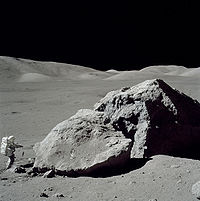 Apollo 17 astronaut Harrison Schmitt standing next to a boulder at Taurus-Littrow during the third EVA (extravehicular activity). NASA photo.
Apollo 17 astronaut Harrison Schmitt standing next to a boulder at Taurus-Littrow during the third EVA (extravehicular activity). NASA photo.
The first man-made object to reach the Moon was the unmanned Soviet probe Luna 2, which made a hard landing on September 14, 1959, at 21:02:24 Z. The far side of the Moon was first photographed on October 7, 1959 by the Soviet probe Luna 3. In an effort to compete with these Soviet successes, U.S. President John F. Kennedy proposed the national goal of landing a man on the Moon. Speaking to a Joint Session of Congress on May 25, 1961, he said
"First, I believe that this nation should commit itself to achieving the goal, before this decade is out, of landing a man on the Moon and returning him safely to the earth. No single space project in this period will be more impressive to mankind, or more important for the long-range exploration of space."[19]
The Soviets nonetheless remained in the lead for some time. Luna 9 was the first probe to soft land on the Moon and transmit pictures from the Lunar surface on February 3, 1966. It was proven that a lunar lander would not sink into a thick layer of dust, as had been feared. The first artificial satellite of the Moon was the Soviet probe Luna 10 (launched March 31, 1966). One of the main impediments to human exploration of the Moon was development of adequate heat shield technology to permit atmospheric re-entry without completely burning up a manned spacecraft. The U.S. gained early supremacy in this field through NASA research in thermogravimetric experiments in hypersonic wind tunnels.
On December 24, 1968, the crew of Apollo 8, Frank Borman, James Lovell and William Anders, became the first human beings to enter lunar orbit and see the far side of the Moon in person. Humans first landed on the Moon on July 20, 1969. The first man to walk on the lunar surface was Neil Armstrong, commander of the U.S. mission Apollo 11. The first robot lunar rover to land on the Moon was the Soviet vessel Lunokhod 1 on November 17, 1970 as part of the Lunokhod program. To date, the last man to stand on the Moon was Eugene Cernan, who as part of the mission Apollo 17 walked on the Moon in December 1972. See also: A full list of lunar Apollo astronauts.
Moon rock samples were brought back to Earth by three Luna missions (Luna 16, 20, and 24) and the Apollo missions 11 through 17 (excepting Apollo 13, which aborted its planned lunar landing).
From the mid-1960s to the mid-1970s there were 65 Moon landings (with 10 in 1971 alone), but after Luna 24 in 1976 they suddenly stopped. The Soviet Union started focusing on Venus and space stations and the U.S. on Mars and beyond, on Skylab and Space Shuttle programs.
Before "moon race" US had a avan-projects of scientific and military moonbases of Werner von Braun, Lunex Project, Project Horizon. Besides the manned landings, abandoned Soviet moon program included a building the multipurpose moonbase Zvezda, first detailed such project with developed mockups of expedition vehicles[20] and surface modules.[21]
Recent exploration
In 1990 Japan visited the Moon with the Hiten spacecraft, becoming the third country to place an object in orbit around the Moon. The spacecraft released the Hagoromo probe into lunar orbit, but the transmitter failed, thereby preventing further scientific use of the mission. In September 2007, Japan launched the SELENE spacecraft, with the objectives "to obtain scientific data of the lunar origin and evolution and to develop the technology for the future lunar exploration", according to the JAXA official website.[22]
The BMDO and NASA launched the Clementine mission in 1994, and Lunar Prospector in 1998.
The European Space Agency launched a small, low-cost lunar orbital probe called SMART 1 on September 27, 2003. SMART 1's primary goal was to take three-dimensional X-ray and infrared imagery of the lunar surface. SMART 1 entered lunar orbit on November 15, 2004 and continued to make observations until September 3, 2006, when it was intentionally crashed into the lunar surface in order to study the impact plume.[23]
The People's Republic of China has begun the Chang'e program for exploring the Moon and is investigating the prospect of lunar mining, specifically looking for the isotope helium-3 for use as an energy source on Earth.[24] China launched the Chang'e 1 robotic lunar orbiter on October 24, 2007. Originally planned for a one-year mission, the Chang'e 1 mission was very successful and ended up being extended for another four months. On March 1, 2009, Chang'e 1 was intentionally impacted on the lunar surface completing the 16 month mission.
On October 1, 2010, China launched the Chang'e 2 lunar orbiter.
India's national space agency, Indian Space Research Organization (ISRO), launched Chandrayaan-1, an unmanned lunar orbiter, on October 22, 2008.[25] The lunar probe was originally intended to orbit the Moon for two years, with scientific objectives to prepare a three-dimensional atlas of the near and far side of the Moon and to conduct a chemical and mineralogical mapping of the lunar surface.[26][27] The unmanned Moon Impact Probe landed on the Moon at 15:04 GMT on November 14, 2008 [28] making India the fourth country to touch down on the lunar surface. Among its many achievements was the discovery of the widespread presence of water molecules in lunar soil.[29]
NASA launched a preliminary unmanned mission, the Lunar Reconnaissance Orbiter, on June 18, 2009. LRO will take high resolution imagery of the Moon's surface and carries the Lunar Crater Observation and Sensing Satellite (LCROSS), which will investigate the possible existence of water in Cabeus crater.
Future plans
Following the abandoned US Constellation program, plans for manned flights followed by moonbases were declared by Russia, Europe (ESA), China, Japan and India. All of them intend to continue the exploration of Moon with more unmanned spacecraft.
China plans to land the rover Chang'e 3 on the Moon in 2012[30] or 2013, and to conduct a sample return mission in 2017. If successful, Chang'e 3 will be the first spacecraft to land on lunar surface, since Luna 24 in 1976.
India expects to launch another indigenous lunar mission by 2013 which would place a motorized rover on the surface of the Moon.[31]
Japanese Aerospace Exploration Agency (JAXA) plans a manned lunar landing around 2020 that would lead to a manned lunar base by 2030; however, there is no budget yet for this project and plan reverts to robotic missions.[32]
Russia also announced to resume its previously frozen project Luna-Glob, an unmanned lander and orbiter, which is slated to launch in 2012.[33]
Germany also announced in March 2007 that it will launch a national lunar orbiter, LEO in 2012.[34] However the mission was cancelled due to budgetary constraints.[35]
In August 2007, NASA stated that all future missions and explorations of the Moon will be done entirely using the metric system. This was done to improve cooperation with space agencies of other countries which already use the metric system.[36]
The European Space Agency has also announced its intention to send a manned mission to the Moon, as part of the Aurora programme. In September 2010 the agency introduces a "Lunar lander" programme with a target of autonomous mission to the moon in 2018.[37]
On September 13, 2007, the X Prize Foundation, in concert with Google, Inc., announced the Google Lunar X Prize. This contest requires competitors "to land a privately funded robotic rover on the Moon that is capable of completing several mission objectives, including roaming the lunar surface for at least 500 meters and sending video, images and data back to the Earth."[38]
Timeline of Moon exploration
Mission (1950–1959) Launch Arrival at Moon Termination Objective Result  Pioneer 0
Pioneer 017 August 1958 17 August 1958 Orbiter Launch failure  Luna E-1 No.1
Luna E-1 No.123 September 1958 23 September 1958 Impactor Launch failure  Pioneer 1
Pioneer 111 October 1958 13 October 1958 Orbiter Launch failure  Luna E-1 No.2
Luna E-1 No.211 October 1958 11 October 1958 Impactor Launch failure  Pioneer 2
Pioneer 28 November 1958 8 November 1958 Orbiter Launch failure  Luna E-1 No.3
Luna E-1 No.34 December 1958 4 December 1958 Impactor Launch failure  Pioneer 3
Pioneer 36 December 1958 7 December 1959 Flyby Launch failure  Luna 1
Luna 12 January 1959 4 January 1959 Impactor Partial success (first successful flyby 5,995 km)  Pioneer 4
Pioneer 43 March 1959 4 March 1959 7 March 1959 Flyby Partial success (flyby 60,000 km)  Luna E-1A No.1
Luna E-1A No.118 June 1959 18 June 1959 Impactor Launch failure  Luna 2
Luna 212 September 1959 13 September 1959 Impactor Success (first spacecraft reaching the moon surface, impacted east of Mare Serenitatis)  Pioneer P-1
Pioneer P-124 September 1959 24 September 1959 Orbiter Launch failure  Luna 3
Luna 34 October 1959 6 October 1959 Flyby Success (first pictures of Moon far side)  Pioneer P-3
Pioneer P-326 November 1959 26 November 1959 Orbiter Launch failure Mission (1960–1969) Launch Arrival at Moon Termination Objective Result  Luna E-3 No.1
Luna E-3 No.115 April 1960 15 April 1960 Flyby Launch failure  Luna E-3 No.2
Luna E-3 No.216 April 1960 16 April 1960 Flyby Launch failure  Pioneer P-30
Pioneer P-3025 September 1960 25 September 1960 Orbiter Launch failure  Pioneer P-31
Pioneer P-3115 December 1960 15 December 1960 Orbiter Launch failure  Ranger 3
Ranger 326 January 1962 28 January 1962 Impactor Failure (flyby)  Ranger 4
Ranger 423 April 1962 26 April 1962 26 April 1962 Impactor Failure (no mid-course correction, crashed at Moon far-side)  Ranger 5
Ranger 518 October 1962 21 October 1962 Impactor Failure (flyby)  Luna E-6 No.2
Luna E-6 No.24 January 1963 11 January 1963 Lander Launched into wrong orbit  Luna E-6 No.3
Luna E-6 No.33 February 1963 3 February 1963 Lander Launch failure  Luna 4
Luna 42 April 1963 >6 April 1963 Lander Failure (flyby)  Ranger 6
Ranger 630 January 1964 2 February 1964 2 February 1964 Impactor Failure (TV camera, only instrument, did not work)  Luna E-6 No.6
Luna E-6 No.621 March 1964 21 March 1964 Lander Launch failure  Luna E-6 No.5
Luna E-6 No.520 April 1964 20 April 1964 Lander Launch failure  Ranger 7
Ranger 728 July 1964 31 July 1964 Impactor Success  Ranger 8
Ranger 817 February 1965 20 February 1965 Impactor Success  Cosmos 60
Cosmos 6012 March 1965 Lander Failed to leave Earth orbit  Ranger 9
Ranger 921 March 1965 24 March 1965 Impactor Success  Luna E-6 No.8
Luna E-6 No.810 April 1965 10 April 1965 Lander Launch failure  Luna 5
Luna 59 May 1965 12 May 1965 Lander Failure (crashed at Sea of Clouds)  Luna 6
Luna 68 June 1965 11 June 1965 Lander Failure (flyby)  Zond 3
Zond 318 July 1965 20 July 1965 Flyby Success  Luna 7
Luna 74 October 1965 7 October 1965 Lander Failure (crashed at Oceanus Procellarum)  Luna 8
Luna 83 December 1965 6 December 1965 Lander Failure (crashed at Oceanus Procellarum)  Luna 9
Luna 931 January 1966 3 February 1966 6 February 1966 Lander Success (first pictures from Moon surface, landed at Oceanus Procellarum)  Cosmos 111
Cosmos 1111 March 1966 3 March 1966 Orbiter Launched into wrong orbit  Luna 10
Luna 1031 March 1966 3 April 1966 30 May 1966 Orbiter Success (first lunar orbiter)  Surveyor 1
Surveyor 130 May 1966 2 June 1966 7 January 1967 Lander Success (landed at Oceanus Procellarum)  Lunar Orbiter 1
Lunar Orbiter 110 August 1966 14 June 1966 29 October 1967 Orbiter Success  Luna 11
Luna 1124 August 1966 27 August 1966 1 October 1966 Orbiter Success  Surveyor 2
Surveyor 220 September 1966 23 September 1966 23 September 1966 Lander Failure (crashed near Copernicus crater)  Luna 12
Luna 1222 October 1966 25 October 1966 19 January 1967 Orbiter Success  Lunar Orbiter 2
Lunar Orbiter 26 November 1966 10 November 1966 11 October 1967 Orbiter Success  Luna 13
Luna 1321 December 1966 24 December 1966 28 December 1966 Lander Success (landed at Oceanus Procellarum)  Lunar Orbiter 3
Lunar Orbiter 35 February 1967 8 February 1967 9 October 1967 Orbiter Partial success (picture acquisition cut short)  Surveyor 3
Surveyor 317 April 1967 20 April 1967 3 May 1967 Lander Success  Lunar Orbiter 4
Lunar Orbiter 44 May 1967 8 May 1967 <31 October 1967 Orbiter Partial success (picture acquisition cut short)  Surveyor 4
Surveyor 414 July 1967 17 July 1967 17 July 1967 Lander Failure (may have exploded before reaching surface)  Lunar Orbiter 5
Lunar Orbiter 51 August 1967 5 August 1967 31 January 1968 Orbiter Success  Surveyor 5
Surveyor 58 September 1967 11 September 1967 17 December 1967 Lander Success  Surveyor 6
Surveyor 67 November 1967 10 November 1967 14 December 1967 Lander Success  Surveyor 7
Surveyor 77 January 1968 10 January 1968 20 February 1968 Lander Success  Luna E-6LS No.112
Luna E-6LS No.1127 February 1968 7 February 1968 Lander Launch failure  Luna 14
Luna 147 April 1968 10 April 1968 Orbiter Success  Zond 5
Zond 515 September 1968 18 September 1968 21 September 1968 Flyby Success (first spacecraft and living beings to return to Earth from lunar flyby)  Zond 6
Zond 610 November 1968 14 November 1968 17 November 1968 Flyby Partial success (depressurisation lead to biologicals death, crashed due to failure in parachute)  Apollo 8
Apollo 821 December 1968 24 December 1968 27 December 1968 Orbiter Success (first manned lunar orbiter)  Luna E-8 No.201
Luna E-8 No.20119 February 1969 19 February 1969 Rover Launch failure  Apollo 10
Apollo 1018 May 1969 21 May 1969 26 May 1969 Orbiter Success (lander test in Moon orbit)  Luna E-8-5 No.402
Luna E-8-5 No.40214 June 1969 14 June 1969 Sample return Launch failure  Luna 15
Luna 1513 July 1969 21 July 1969 Sample return Failure (crashed at Mare Crisium)  Apollo 11
Apollo 1116 July 1969 19 July 1969 24 July 1969 Orbiter Success 20 July 1969 21 July 1969 Sample return Success (21.5 kg of lunar rocks retrieved, first humans on the Moon surface)  Zond 7
Zond 77 August 1969 11 August 1969 14 August 1969 Flyby Success  Cosmos 300
Cosmos 30023 September 1969 23 September 1969 Sample return Launched into wrong orbit  Cosmos 305
Cosmos 30522 October 1969 22 October 1969 Sample return Launched into wrong orbit  Apollo 12
Apollo 1214 November 1969 17 November 1969 24 November 1969 Orbiter Success 19 November 1969 20 November 1969 Sample return Success (First precise landing, recovered parts from Surveyor 3) Mission (1970–1979) Launch Arrival at Moon Termination Objective Result  Apollo 13
Apollo 1311 April 1970 15 April 1970 17 April 1970 Sample return Failure (flyby, crew returned to Earth)  S-IV
S-IV14 April 1970 14 April 1970 Impactor Success (provided signal for the Apollo 12 Passive Seismic Experiment)  Luna E-8-5 No.405
Luna E-8-5 No.4056 February 1970 6 February 1970 Sample return Launch failure  Luna 16
Luna 1612 September 1970 20 September 1970 24 September 1970 Sample return Success (first robotic lunar sample return, 101 g)  Zond 8
Zond 820 October 1970 24 October 1970 27 October 1970 Flyby Success  Luna 17
Luna 1710 November 1970 17 November 1970 17 November 1970 Lander Success (soft-landed the Lunokhod 1)  Lunokhod 1
Lunokhod 114 September 1971 Rover Success (First lunar rover)  Apollo 14
Apollo 1431 January 1971 4 February 1971 9 February 1971 Orbiter Success 5 February 1971 6 February 1971 Sample return Success  Apollo 15
Apollo 1526 July 1971 29 July 1971 7 August 1971 Orbiter Success 30 July 1971 2 August 1971 Sample return Success (first manned Lunar Roving Vehicle)  Luna 18
Luna 182 September 1971 11 September 1971 11 September 1971 Sample return Failure (crashed near the edge of the Sea of Fertility)  Luna 19
Luna 1928 September 1971 3 October 1971 3–20 October 1972 Orbiter Success  Luna 20
Luna 2014 February 1972 21 February 1972 25 February 1972 Sample return Success  Apollo 16
Apollo 1616 April 1972 19 April 1972 27 April 1972 Orbiter Success 21 April 1972 23 April 1972 Sample return Success  Apollo 17
Apollo 177 December 1972 10 December 1972 19 December 1972 Orbiter Success 11 December 1972 15 December 1972 Sample return Success (first geologist on the Moon)  Luna 21
Luna 218 January 1973 15 January 1973 15 January 1973 Lander Success (soft-landed the Lunokhod 2)  Lunokhod 2
Lunokhod 23 June 1973 Rover Success  Luna 22
Luna 2229 May 1974 2 June 1974 early November 1975 Orbiter Success  Luna 23
Luna 2328 October 1974 6 November 1974 9 November 1975 Sample return Partial success (sample drilling failed)  Luna 24
Luna 249 August 1976 18 August 1976 22 August 1976 Sample return Success Mission (1990–1999) Launch Arrival at Moon Termination Objective Result  Hiten
Hiten24 January 1990 19 March 1990 10 April 1993 Orbiter Success (first aerobraking maneuver by a deep space probe)  Clementine
Clementine25 January 1994 19 February 1994 June 1994 Orbiter Success  Lunar Prospector
Lunar Prospector7 January 1998 11 January 1998 31 July 1999 Orbiter Success Mission (2000–2009) Launch Arrival at Moon Termination Objective Result  SMART-1
SMART-127 September 2003 15 November 2004 3 September 2004 Orbiter Success (first use of an ion engine to reach the Moon)  SELENE
SELENE14 September 2007 3 October 2007 10 June 2009 Orbiter Success  Chang'e 1
Chang'e 124 October 2007 5 November 2007 1 March 2009 Orbiter Success  Chandrayaan-1
Chandrayaan-122 October 2008 12 November 2008 29 August 2009 Orbiter Success (discovery of water on the moon)  Moon Impact Probe
Moon Impact Probe14 November 2008 14 November 2008 Impactor Success (first Asian object on the surface of the moon)  Lunar Reconnaissance Orbiter
Lunar Reconnaissance Orbiter18 June 2009 23 June 2009 ongoing Orbiter Success  Shepherding spacecraft (LCROSS)
Shepherding spacecraft (LCROSS)9 October 2009 9 October 2009 Impactor Success (near observation of Centaur impact)  Centaur upper stage (LCROSS)
Centaur upper stage (LCROSS)9 October 2009 9 October 2009 Impactor Success Mission (2010–Present) Launch Arrival at Moon Termination Objective Result  Chang'e 2
Chang'e 21 October 2010 5 October 2010 ongoing Orbiter Success  Gravity Recovery and Interior Laboratory
Gravity Recovery and Interior Laboratory10 September 2011 ongoing Two orbiters Future missions
Name Estimated launch Elements Notes  Lunar Atmosphere and Dust Environment Explorer
Lunar Atmosphere and Dust Environment Explorer1 May 2012 Orbiter Instruments will include a dust detector, a neutral mass spectrometer, an ultraviolet-visible spectrometer, and a laser communications terminal.  Luna-Glob
Luna-Glob2012 Orbiter Orbiter to include astrophysics experiments, dust monitors, plasma sensors, including the LORD astronomy payload, designed to study ultra-high-energy cosmic rays.[39] Carries cancelled Lunar-A penetrators.  Lunar-A penetrators
Lunar-A penetratorsImpactor Two penetrators to deeply penetrate the lunar regolith on opposite sides of Moon.[citation needed] 
 Chandrayaan-2
Chandrayaan-22014 Orbiter, lander, rover Orbiter to carry five payloads, three new, while other two are improved versions of those on Chandrayaan-1.The Russian Federal Space Agency will provide the lander that will carry the Indian rover.  Chang'e 3
Chang'e 32013 Rover Six-wheeled lunar vehicle to be landed at Sinus Iridum.  Astrobotic Technology
Astrobotic Technology2013–2014 Lander, Rover First scheduled launch of a private lander, rover and moon payload competing for various prizes including the Google Lunar X Prize.[40] See also
- Colonization of the Moon
- Helium-3
- List of lunar probes
- List of artificial objects on the Moon
- Moon landing
- Project Apollo
- Robotic exploration of the Moon
- Timeline of Solar System exploration
References
- ^ A. Aaboe, J. P. Britton, J. A. Henderson, Otto Neugebauer, A. J. Sachs (1991). "Saros Cycle Dates and Related Babylonian Astronomical Texts". Transactions of the American Philosophical Society (American Philosophical Society) 81 (6): 1–75. doi:10.2307/1006543. JSTOR 1006543. "One comprises what we have called "Saros Cycle Texts," which give the months of eclipse possibilities arranged in consistent cycles of 223 months (or 18 years)."
- ^ van der Waerden, Bartel Leendert (1987). "The Heliocentric System in Greek, Persian and Hindu Astronomy". Annals of the New York Academy of Sciences 500: 1–569. doi:10.1111/j.1749-6632.1987.tb37193.x. PMID 3296915.
- ^ Sarma (2008), Astronomy in India
- ^ Hayashi (2008), Aryabhata I
- ^ O'Connor, J.J.; Robertson, E.F. (February 1999). "Anaxagoras of Clazomenae". University of St Andrews. http://www-history.mcs.st-andrews.ac.uk/Biographies/Anaxagoras.html. Retrieved 2007-04-12.
- ^ Lewis, C. S. (1964). The Discarded Image. Cambridge: Cambridge University Press. pp. 108. ISBN 0-521047735-2.
- ^ a b c d e f g "The Galileo Project". http://galileo.rice.edu/sci/observations/Moon.html. Retrieved 2007-09-14.[dead link]
- ^ Needham, Joseph (1986). Science and Civilization in China. 3, Mathematics and the Sciences of the Heavens and Earth. Taipei: Caves Books. p. 411. ISBN 0-521058015.
- ^ a b c Needham, Joseph (1986). Science and Civilization in China. 3, Mathematics and the Sciences of the Heavens and Earth. Taipei: Caves Books. pp. 413–414. ISBN 0-521058015.
- ^ Needham, Joseph (1986). Science and Civilization in China. 3, Mathematics and the Sciences of the Heavens and Earth. Taipei: Caves Books. p. 227. ISBN 0-521058015.
- ^ a b Needham, Joseph (1986). Science and Civilization in China. 3, Mathematics and the Sciences of the Heavens and Earth. Taipei: Caves Books. pp. 415–416. ISBN 0-521058015.
- ^ Langermann, Y. Tzvi (1985). "The Book of Bodies and Distances of Habash al-Hasib". Centaurus 28 (2): 108–128 [112]. doi:10.1111/j.1600-0498.1985.tb00831.x.
- ^ Langermann, Y. Tzvi (1985). "The Book of Bodies and Distances of Habash al-Hasib". Centaurus 28 (2): 108–128 [111]. doi:10.1111/j.1600-0498.1985.tb00831.x.
- ^ Hershenson, Maurice (1989). The Moon illusion. Routledge. pp. 9–10. ISBN 9780805801217.
- ^ Toomer, G. J. (December 1964). "Review: Ibn al-Haythams Weg zur Physik by Matthias Schramm". Isis 55 (4): 463–465. doi:10.1086/349914.
- ^ Van Helden, A. (1995). "The Moon". Galileo Project. http://galileo.rice.edu/sci/observations/moon.html. Retrieved 2007-04-12.
- ^ Энциклопедия для детей (астрономия). Москва: Аванта+. 1998. ISBN 5-89501-016-4.
- ^ Boese, A. (2002). "The Great Moon Hoax". Museum of Hoaxes. http://www.museumofhoaxes.com/moonhoax.html. Retrieved 2007-04-12.
- ^ Special Message to the Congress on Urgent National Needs Page 4 - John F. Kennedy Presidential Library & Museum
- ^ LEK Lunar Expeditionary Complex
- ^ DLB Module
- ^ "Kaguya (SELENE)". JAXA. http://www.selene.jaxa.jp/index_e.htm. Retrieved 2007-06-25.
- ^ "SMART-1 Impacts Moon". ESA. 4 September 2006. Archived from the original on 2006-10-25. http://web.archive.org/web/20061025000823/http://www.esa.int/esaCP/SEMBY5BVLRE_index_0.html. Retrieved 2006-09-03.
- ^ David, Leonard (04 March 2003). "China Outlines its Lunar Ambitions". Space.com. http://space.com/missionlaunches/china_Moon_030304.html. Retrieved 2006-03-20.[dead link]
- ^ http://www.ndtv.com/convergence/ndtv/Moonmission/Election_Story.aspx?id=NEWEN20080069654
- ^ "Chandrayaan-1 Scientific Objectives". Indian Space Research Organisation. http://www.isro.org/chandrayaan/htmls/objective_scientific.htm.
- ^ http://www.deccanherald.com/CONTENT/Sep192008/national2008091890838.asp
- ^ "India sends probe on to the Moon". BBC. November 14, 2008. http://news.bbc.co.uk/2/hi/south_asia/7730157.stm. Retrieved 2008-11-16.
- ^ Lunar Missions Detect Water on Moon
- ^ "China's second moon orbiter Chang'e-2 goes to outer space". http://news.xinhuanet.com/english2010/china/2011-06/09/c_13920425.htm.
- ^ Staff Writers (2004-11-04). "Competition heating up for Moon exploration". IOL. http://www.iol.co.za/index.php?set_id=1&click_id=31&art_id=qw1101276721575B253. Retrieved 2008-01-25.
- ^ Staff Writers (2006-08-03). "Japan Plans Moon Base By 2030". Moon Daily. SpaceDaily. http://www.Moondaily.com/reports/Japan_Plans_Moon_Base_By_2030_999.html. Retrieved 2006-11-17.
- ^ Covault, Craig (2006-06-04). "Russia Plans Ambitious Robotic Lunar Mission". http://www.aviationnow.com/avnow/news/channel_awst_story.jsp?id=news/aw060506p2.xml.
- ^ news, Spiegel (2007-02-28). "Germany plans own Moon mission". http://www.spiegel.de/wissenschaft/weltall/0,1518,469219,00.html.
- ^ http://www.n-tv.de/Nur_gucken_Nicht_anfassen_MondMission_geplatzt/120720081208/992885.html
- ^ NASA - Metric Moon
- ^ http://www.esa.int/esaCP/SEMUV2KOXDG_index_0.html
- ^ "Google Sponsors Lunar X PRIZE to Create a Space Race for a New Generation". X PRIZE Foundation. http://www.googlelunarxprize.org/lunar/press-release/google-sponsors-lunar-x-prize-to-create-a-space-race-for-a-new-generation. Retrieved 2007-09-13.
- ^ http://space.skyrocket.de/doc_sdat/luna-glob.htm
- ^ "SpaceX Lands Contract To Fly To Moon". Aviation Week. 2011-02-08. http://www.aviationweek.com/aw/generic/story_channel.jsp?channel=space&id=news/asd/2011/02/08/01.xml&headline=SpaceX%20Lands%20Contract%20To%20Fly%20To%20Moon. Retrieved 2011-02-08. "Pittsburgh-based Astrobotic Technology, a Carnegie Mellon University spin-off company, has signed a launch services contract with Space Exploration Technologies (SpaceX) for a Falcon 9 rocket to deliver a lander, small rover and up to about 240 lb. of payload to the surface of the Moon"
External links
- Lunar mission timeline - NASA
- Recent Lunar missions - NASA
- Exploring the Moon - A history of lunar discovery from the first space probes to recent times
- Another Hit to Hoax:Traces of Man on Lunar Surface
Manned lunar spacecraft Orbiters 
Landers Robotic exploration of the Moon Programs Orbiters Planned Proposed Flybys Impactors Landers Rovers S. Return Cancelled See also - Moon
- Exploration of the Moon
- Colonization of the Moon
- Manned lunar spacecraft
- List of artificial objects on the Moon
- List of current and future lunar missions
- List of lunar probes
- Apollo
- CCCP manned lunar plan
Bold italics indicates active missions Exploration of the Solar System Exploration of other planets: Exploration of the Moon · Exploration of Mercury · Exploration of Venus · Exploration of Mars · Exploration of Jupiter · Exploration of Saturn · Exploration of Uranus · Exploration of NeptuneLists: Objects on other planets The Moon Physical features 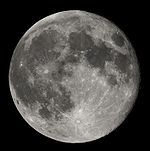
Orbit Lunar surface Selenography · Near side · Far side · Lunar mare (List) · Craters (List) · Mountains · Valleys · South Pole – Aitken basin · Shackleton crater · Water · Soil · Peak of eternal light · Space weathering · Transient lunar phenomenonLunar science Exploration Exploration of the Moon · Apollo program · Robotic exploration · Future missions · Lunar colonization · Moon Landing hoax accusationsOther topics See also Solar System · Natural satellite Categories:- Exploration of the Moon
- Manned spacecraft
- Lunar spacecraft
Wikimedia Foundation. 2010.


